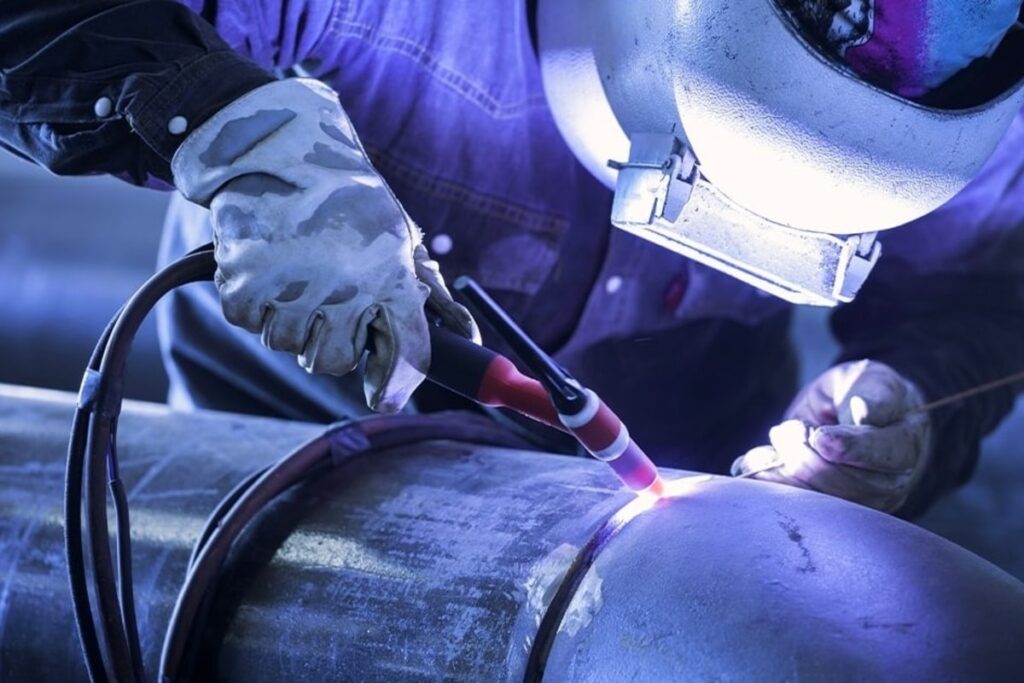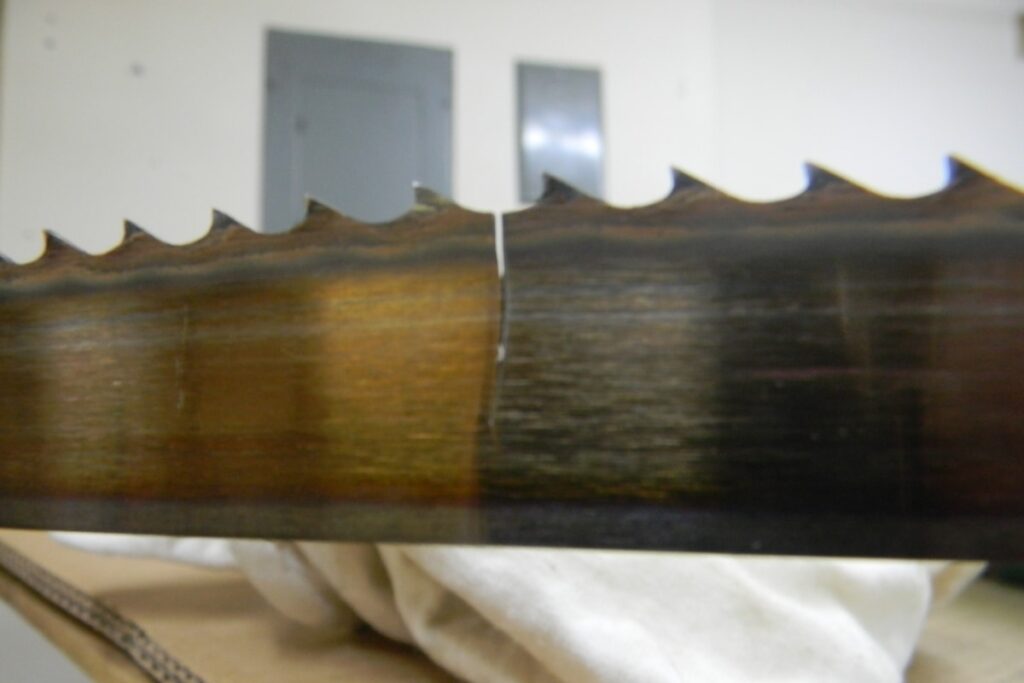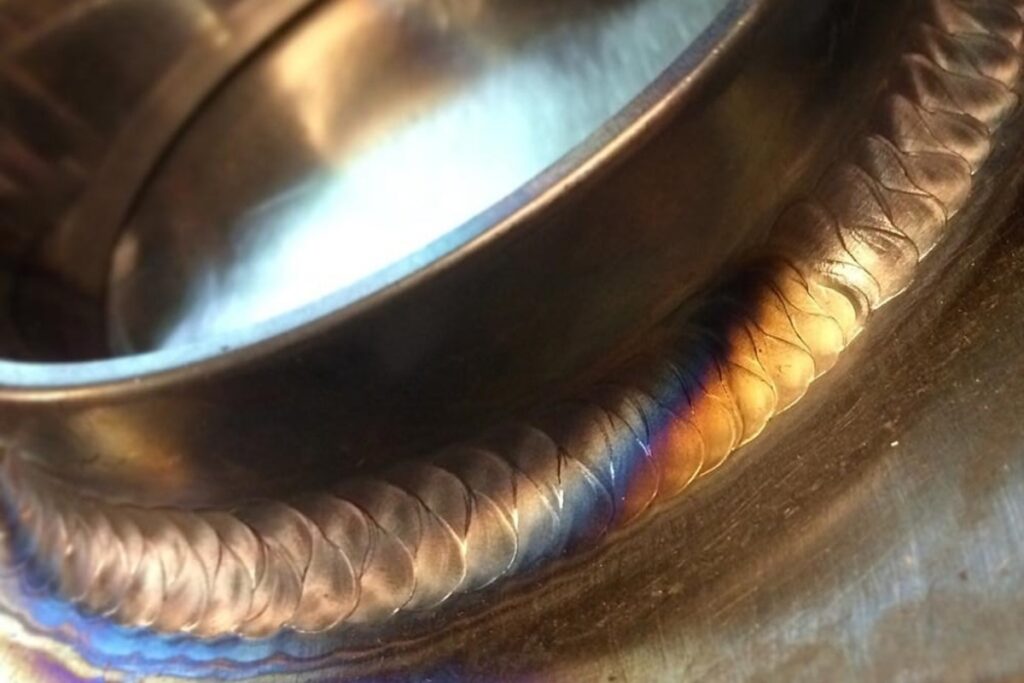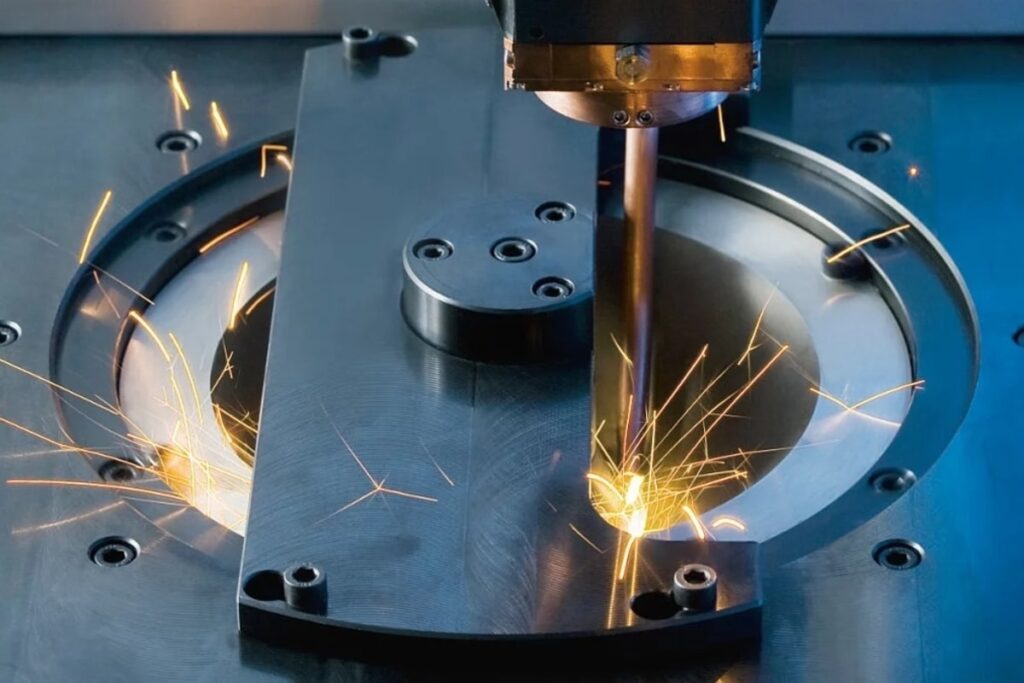If you’re new to the world of metalworking, one thing that may have come up during your research is whether nitrogen would work as a shielding gas during a tungsten inert gas (TIG) welding operation. The answer is “no,” at least not on its own.
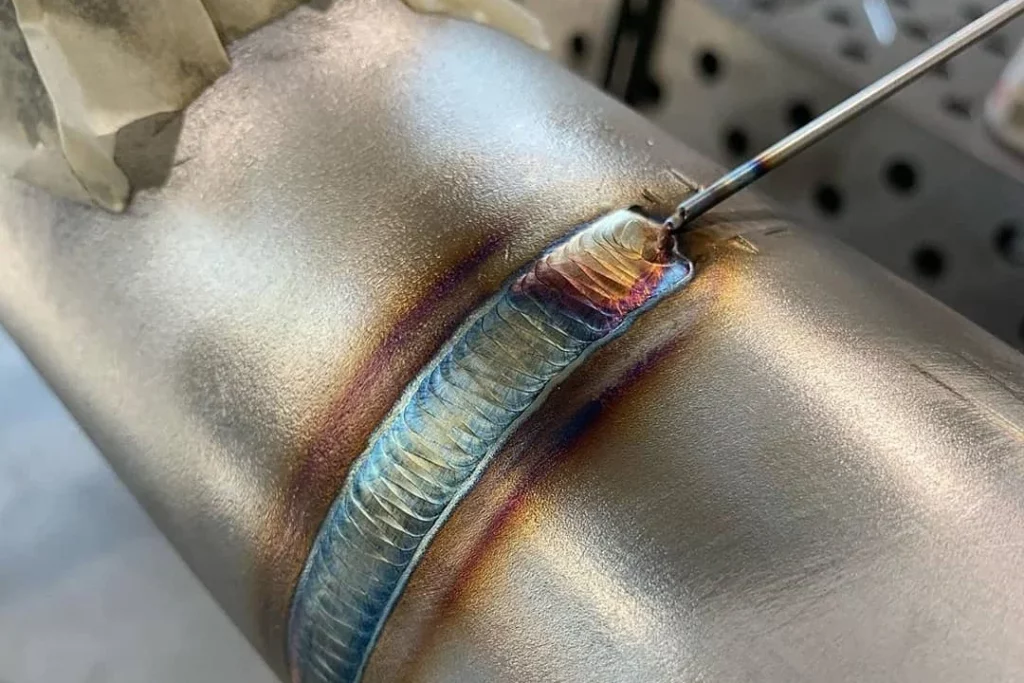
In this article, we’ll discuss how to use nitrogen for TIG welding, why it’s often necessary, what duplex stainless steel is, and more. And don’t worry if you want to skip ahead—we’ve included links to jump between sections so you can learn everything quickly!
- Using Nitrogen for TIG Welding
- The Role of Shielding Gases in Welding
- What You Shouldn’t Do When TIG Welding
- Why Is Argon Superior to Nitrogen for TIG Welding?
- Why Is Argon Often Paired With Nitrogen for TIG Welding?
- When to Avoid Using Argon for TIG Welding
- What Is Duplex Stainless Steel?
- How to Use Nitrogen to TIG Weld Duplex Stainless Steel
- The Bottom Line
Let’s start by examining how to properly use nitrogen for TIG welding.
Using Nitrogen for TIG Welding
While nitrogen does make an excellent choice for certain applications, such as arc cutting, it won’t work well as a sole source of protecting gases like oxygen and hydrogen from being consumed by the welding process. Instead, it needs something else to go along with it to do the job properly.
So, to anwser the question: Can you use nitrogen for TIG welding? You cannot use nitrogen alone for TIG welding. You need to combine it with another ingredient. This extra ingredient comes in the form of another inert gas—helium or argon.
Why You Should Use Nitrogen in Combination With Helium for TIG Welding
Helium makes a great shield because, unlike other gases such as neon or xenon, it doesn’t react chemically with metals like aluminum alloys or copper under normal circumstances. It also has good heat transfer properties, which means less time spent transferring energy into the joint. In addition, it helps prevent oxidation and spattering inside the shielded area.
So how exactly are these benefits achieved through helium?
How Helium Helps Nitrogen While TIG Welding
First off, it prevents reactive atoms such as carbon, silicon, and phosphorus from reaching the molten pool where they could potentially combine with elements already present there and create unwanted impurities. This keeps the mix cleaner than if just nitrogen were used alone.
Due to its high molecular weight and low density compared to nitrogen, helium is also able to absorb some additional heat. These two factors allow it to dissipate the excess heat generated by the TIG torch better than regular air molecules could.
Now that you know about both types of inert gases and their unique characteristics, let’s move on to why they’re needed together for proper performance when joining different materials.
The Role of Shielding Gases in Welding
Shielded-gas welding involves using multiple layers of protection over the region where a joint will take place. Each layer shields against different kinds of emissions.
For example, the first layer protects against spatter caused by any contaminants in the atmosphere. If too much dirt gets into the chamber where the welding takes place, it can easily become trapped near the target material surface and burn away during the process.
The second layer provides a barrier against oxygen, which causes oxide buildup in joints. Oxygen reacts with metals, causing them to harden prematurely and lose strength.
A third layer protects against the effects of nitrogen leaking out into the room from the system itself. As discussed earlier, N2 isn’t very effective at absorbing incoming heat. When it leaves behind hot areas after processing, those pockets provide ideal conditions for combustion.
Combustion releases harmful fumes that can cause lung damage, asphyxia, irritation, and even death. So, having lots of nitrogen around the workplace poses serious health hazards. Luckily, since each type of inert gas serves a specific purpose, they aren’t usually mixed together before leaving the factory.
Let’s now talk about why helium is added to nitrogen and why it works so well with TIG welding.
What You Shouldn’t Do When TIG Welding
We’ve established that shielding gases play a vital role in a number of industrial processes, including brazing, soldering, plasma etching, etc., but perhaps the most important instance where shielding gases are required is in TIG welding. Even though it was developed back in the 1940s, TIG remains popular today among novice and professional welders alike thanks to its relatively simple setup.
Beginner’s Mistake
Most people who start out learning TIG welding end up doing so without ever purchasing a pure nitrogen supply line. They either get hold of standard household compressed air or purchase an expensive nitrous oxide cylinder for creating bubbles.
While this approach gives beginners a chance to familiarize themselves with basic concepts related to TIG welding, it falls short when it comes to achieving consistent results. That’s because nitrogen isn’t actually inert—it contains many free radicals that readily interact with tungsten particles.
Thus, the resulting sparks that occur when using pure nitrogen contain significant amounts of carbon and calcium oxides. To improve upon this situation, manufacturers began combining nitrogen with other gases, namely argon and helium.
Why Is Argon Superior to Nitrogen for TIG Welding?
1. Argon Improves the Quality of the Joint
Argon offers superior shielding qualities compared to nitrogen and reduces the amount of stray current that reaches the molten pool. Since argon also absorbs more heat than nitrogen, fewer cycles need to be performed per inch, resulting in faster overall production times.
By contrast, nitrogen requires longer intervals between passes due to its lower melting point. With argon, shorter dwell periods can minimize exposure to undesirable side reactions. Overall, argon greatly improves the quality of the finished product.
2. Nitrogen Isn’t as Efficient as Argon
On top of providing improved shielding, argon can help reduce the size of the molten puddle formed after making a pass over the same spot. This happens because argon has a higher boiling point than nitrogen.
In fact, the differences in boiling points account for why argon and nitrogen are sometimes referred to as upper and lower-grade gases, respectively. Because nitrogen boils at -195.8 degrees Celsius (-320.4 °F), whereas argon boils at -185.8 degrees Celsius (-303 °F), nitrogen tends to evaporate faster once exposed to the molten pool. As soon as the evaporation reaction starts, the smaller volume becomes depleted faster than the larger volume, thereby reducing the total amount of fuel available within the shielded zone.
Because argon burns at a slower rate than nitrogen, it allows enough time for residual argon leftovers to escape via convection. However, if nitrogen is used instead of argon, then the same effect wouldn’t happen because nitrogen boils at a comparatively low temperature. Consequently, a large portion of the nitrogen would remain in the shielded area. Once again, poor ignition conditions would result, leading to inconsistent finishes and reduced productivity.
3. Nitrogen Creates Increased Porosity and Weak Spots
Another reason why argon is preferred is that it suppresses the formation of oxides on the tip of the electrode head. Over time, this leads to irregularly shaped tips that produce inferior penetration depths, increased porosity, and weak spots.
Compared to argon, nitrogen creates far greater quantities of oxides, especially at temperatures above 1,800 °F (982 °C). At these elevated levels, nitrogen promotes more rapid oxidation reactions that eventually lead to the complete depletion of the electrodes’ coating.
4. Argon Produces a More Stable Electrical Arc
Finally, argon also produces a more stable electrical arc. Without argon, the current flowing between the tip and base of the electrode might fluctuate wildly. During long stretches of time, the voltage level may drop significantly below the safe range. Conversely, the presence of argon minimizes the fluctuations, allowing workers to perform repetitive tasks safely for extended periods of time.
Why Is Argon Often Paired With Nitrogen for TIG Welding?
To wrap things up, argon is commonly paired with nitrogen because it satisfies three primary criteria that make a big difference when welding:
Since argon performs admirably in all three aforementioned ways, it’s typically recommended for use with TIG welding procedures involving nonferrous metals, such as aluminum alloys, magnesium alloy castings, brass plumbing fittings, etc.
When to Avoid Using Argon for TIG Welding
On the flipside, argon is considered ill-suited for welding ferrous metals, such as mild steel sheeting, wrought iron pipe, galvanized surfaces, etc. Why? Basically, argon’s ability to suppress fluctuations in electrical arcs is largely dependent on the physical structure of the underlying metal. Soft metals lack sufficient rigidity to effectively constrain electrons and ions.
Therefore, arcing tends to change unpredictably, ultimately affecting the integrity of the weld. The opposite is true for harder metals. For example, austenitic steel tends to retain constant resistivity values regardless of changes in the intensity of the electric field.
What Is Duplex Stainless Steel?
Before delving deeper into why nitrogen can’t serve as a suitable replacement for argon when working with various metals, let’s briefly touch on the concept of stainless steel.
Although the term refers to a family of similar substances made primarily from chromium, nickel, manganese, molybdenum, and carbon, it’s generally understood to mean anything containing at least 10 percent chromium.
Stainless steel owes its name to its chemical composition rather than its visual appearance. Most commercial grades contain about 20% chromium, though the concentration varies greatly depending on the exact mixture.
The Benefits of Stainless Steel in TIG Welding
One of the reasons why stainless steel became such a common manufacturing method is that it resists corrosion in acidic environments.
Another reason is that it’s resistant to chloride-ion attacks found in seawater. Depending on the percentage of chromium contained within the compound, the resulting steel can withstand moisture contact for anywhere from 24 hours to several years. Because of its remarkable durability, it has found widespread use in industries ranging from food packaging to medical equipment to construction vehicles.
When referring to TIG welding specifically, however, the usage of words such as duplex, triplex, and quadruple indicates that the steel contains a minimum of 2%, 3%, or 4% chromium, respectively.
How to Use Nitrogen to TIG Weld Duplex Stainless Steel
The ideal gas composition for welding duplex stainless steel is a mixture of argon and nitrogen. When it comes to pitting corrosion, nitrogen, in particular, plays a significant role in the corrosion performance of the material. A more stable arc may also result from it.
Additionally, when welding duplex stainless steel, argon plays a crucial role in the alloy. Argon make up for any nitrogen that might have been lost from the weld pool when it is added.
Given that shielding gases are primarily employed for their excellent corrosion resistance, they can lower scrapping rates and additional expenses, and help retain the material’s durability.
The best proportion will be achieved and the integrity of duplex stainless steel will be maintained by adding just about two percent of nitrogen gas to the Argon shielding gas.
The Bottom Line
Can you TIG weld with nitrogen? You can use nitrogen for TIG welding. However, it should only be used in specific circumstances and only in combination with argon or helium gas.
By outlining some of the fundamentals of how shielding gas interacts with TIG welding, this article has hopefully brought you one step closer to some best practices in the welding business.
Darell is a Certified Welding Engineer (CWEng) with over 23 years of expertise in TIG, MIG, MAG, dual flux, and stick welding. He is a senior welding engineer who has a desire to share his experience. Visit unwelded.com and join Darell as well as other welding enthusiasts in obtaining fabrication knowledge, amazing welding gadgets, and useful welding insights.
